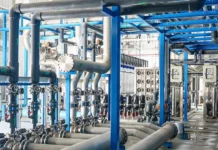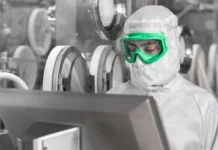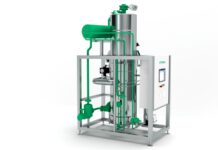When it comes to automation technology, the pharmaceutical industry is now at a very major crossroads that is being pushed by tremendous advancements in the field. As a result of advancements of this kind, the procedures involved in the production of pharmaceuticals are being elevated, and packaging and distribution of pharmaceutical goods are also undergoing revolutionary changes.
The global market for pharmacy automation devices is projected to grow at a compound annual growth rate (CAGR) of 9.9% through 2030.
In point of fact, this sort of expansion may be related to the rise in the global illness burden as well as the growing use of prescription medications. At the same time as there has been an increase in the number of prescriptions, there has also been an increase in the need for automation technology. This is being done in order to minimize the number of pharmaceutical mistakes during the distribution process and to allow quick prescription dispensing. In addition to this, pharmacy automation devices continue to assist in the prevention of product contamination as well as mistakes, which ultimately results in a reduction in the risk associated with liabilities and an increase in the level of patient safety.
These sorts of gadgets help cut down on the amount of medicine that is wasted, which in turn brings a reduction in expenditures over the course of time.
It is of the utmost importance to have a comprehensive understanding of how technological advancements and upgrades are reshaping drug packaging systems. These advancements are ensuring safety, efficacy, and precision at every stage of the medication management chain. As one continues to delve deeper into automation, it is essential to have this understanding.
Smart packaging technology is a method that may improve the results for patients.
As a matter of fact, the advent of smart packaging solutions is one of the most noticeable trends that can be seen within the landscape of pharmaceutical packaging. In order to improve the compliance of patients and, at the same time, monitor the product’s integrity throughout its entire lifespan, such innovative systems make use of cutting-edge technology such as RFID chips, near field communication, and Internet of Things connection. These technologies are used to boost the compliance of patients.
For instance, the smart blister packs have the capability to not only notify patients when it is time for them to take their medications, but they can also record data that is genuine, which can then be retrieved by the medical professionals. Additionally, this technology not only helps to improve patient outcomes, but it also links with the patients’ personal health data in a seamless manner, which enables it to provide a more comprehensive perspective on the patient’s pharmaceutical regimen.
The use of automation ensures that compounding and dispensing are carried out with accuracy.
In point of fact, automation technology has revolutionized the conventional approaches to the distribution of pharmaceuticals, making them not only more effective but also more accurate. The automated dispensing systems are used in a broad variety of settings, including hospitals and pharmacies. These systems reduce the likelihood of errors caused by human intervention, improve the accuracy of medicine dose, and significantly reduce the danger of contamination. These sorts of systems are especially important when it comes to the administration of highly high-stakes medications, which are situations in which accuracy is of the highest importance.
When it comes to intravenous drugs, automated compounding systems not only save the pharmacists time but also guarantee that the dosages are blended in the most correct manner possible, which ultimately contributes to an increase in the patient’s level of safety.
There is no denying the fact that the introduction of 3D printing in the field of pharmaceuticals ushers in a whole new age of personalized treatment. By using this technology, it is possible to create complex medicine formulations that are tailored to meet the specific requirements of individual patients. It is possible, for instance, to build tablets that are produced using 3D printing technology in such a manner that they release drugs at a pace that is predefined and adapted to the patient’s absorption ability, so improving the therapeutic effects. In addition, these kinds of printers are able to produce pills that include many layers of drugs, which makes it possible to combine a number of different prescriptions into a single pill that has a variety of release periods.
The automation of this process not only makes the production scenario more efficient, but it also reduces the possibility of errors caused by human intervention, which contributes to the guarantee that each batch satisfies the necessary requirements.
Investigating the difficulties associated with automation is necessary.
The use of automated technology into the packaging of pharmaceuticals is not without its challenges, despite the fact that significant breakthroughs have been made. The high cost that is involved in implementing advanced technology like robots and artificial intelligence is a significant obstacle, particularly for the firms that are on the smaller side. Additionally, the regulatory difficulties slow down the adoption of new technology since it is necessary to comply with stringent requirements. This occurs because of the fact that compliance is required.
When it comes to automated systems, the change requires a workforce that is up to speed with robotics, data analysis, and digital management. In addition, the workforce must be able to handle digital management. As the industry continues to undergo change, there is a growing need for continuous training and development in order to provide workers with the necessary skills to effectively handle such cutting-edge technology. This is necessary in order to ensure that workers are able to effectively manage the sector.
In spite of this, it is certain that the future of pharmaceutical packaging and medication systems will undoubtedly be characterized by a solution that is much more automated and individualized. As things continue to progress, it is going to be extremely important for there to be continuous innovation as well as cooperation among the corporations that produce technology, pharmaceutical companies, and regulatory agencies.
There is no doubt that the goal is very obvious. When it comes to improving the safety of the drugs, the effectiveness of the treatment, and the patient’s compliance, it is essential to make the most of automation. With the help of such technology, the pharmaceutical industry is prepared to provide healthcare solutions that are both responsible and responsive. As a result, tremendous progress will be made in terms of improving the results for patients and ensuring a healthier future.




















